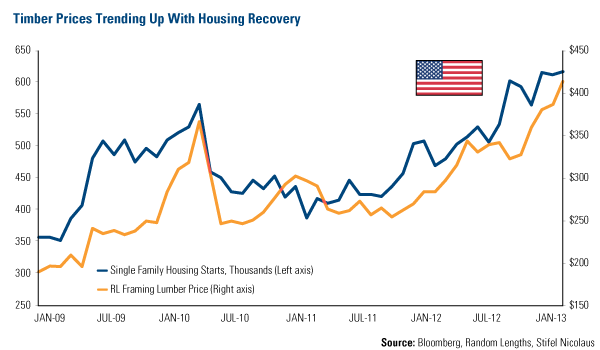Energy and Natural Resources Market Radar (March 25, 2013)
Strengths
- Natural gas futures climbed to an 18-month high in New York as an unusually cold start to spring in the U.S. may bolster demand for the heating fuel.
- The Baltic Exchange's main sea freight index, which tracks rates for ships carrying dry bulk commodities, continued its upward trend this week for the 17th consecutive day, pushed up by rates across all shipping segments.
- World steel production for February 2013 at 123 million tonnes was up 1.2 percent year-over-year driven by China, where production at 61.8 million tonnes was up 9.8 percent year-over-year.
Weaknesses
- Rallies in industrial metals led by stronger than expected HSBC China flash PMI were short lived with copper reversing its gains to reach a four-month low this week.
- U.S. raw steel production last week was 1.62 million tonnes, which is a fall of 2.35 percent week-on-week and means that capacity utilization is down to 74.5 percent, the second lowest level year to date. In addition, overall steel output in the first 11 weeks of this year is over 5 percent lower than the same period in 2012.
- Colombia exported 2.9 million tonnes of coal in February, the lowest monthly figure for the past 10 years and just 11 percent higher than the 2.6 million tonnes shipped during February 2003. Striking miners, port delays, and rail logistical problems all contributed to the weak exports.
Opportunities
- Later this year, U.S. oil production is set to surpass the amount of crude the country imports for the first time since 1995, the U.S. Energy Information Administration (EIA) said this week. The boom in U.S. shale or tight oil production unleashed by advances in horizontal drilling and hydraulic fracturing, known as "fracking,” is expected to see U.S. output top 8 million barrels per day by the end of 2014, the EIA said. That would be the highest level since 1988.
- China may have 20-30 million tons of annual shortage in feed grain supply in 2-3 years, boosting needs for imports, Yi Ganfeng, vice president of Beijing Dabeinong Technology Group, the country’s second-biggest feed miller, said on the sideline of the JCI grain conference in Kunming. As China’s livestock industry matures, feed mills will prefer to use bulk-commodity grain, including corn and dried distillers’ grains, in place of traditional materials such as oilseed meal, used by smaller farms now. China’s meat demand may expand about 25 percent from current levels in about 5 years, spurring consumption of feed grain. China would import 10 million tons of corn a year now if there were no policies restricting imports.
Threats
- U.S. drivers may face a $13 billion increase in the cost of gasoline this year as the price of federally mandated ethanol credits has risen 10-fold for oil refiners. Oil refiners such as Valero, the world’s largest independent refiner, and Exxon Mobil are pushing the U.S. Environmental Protection Agency to reduce the amount of ethanol they’re required to add to gasoline to avoid what they say will be a sharp spike in prices at the pump just as the summer driving season begins.
- Refiners buy biofuel credits, known as RINs, which are available as an alternative to actually blending ethanol into gasoline. The cost of those credits has ballooned from seven cents at the start of the year to more than $1 as the 2013 federal mandate for biofuel exceeds 10 percent of gasoline sales, the maximum that refiners say the market can absorb.
- At the annual gathering of the American Fuel and Petrochemical Manufacturers in San Antonio yesterday, Michael Jennings, chairman and chief executive officer of Dallas-based refiner HollyFrontier Corp., said energy traders and hedge funds are treating ethanol credits like a casino, which “will drive, in its current form, higher prices at the pump.” Consumers are at risk of paying 10 cents a gallon more for gasoline this year if the ethanol credits continue to sell at a price of more than $1.
- The Wall Street Journal is cautious on iron ore miners. A "Heard on the Street" column says with most forecasters seeing a drop in iron ore prices, miners should proceed with care and maintain a healthy price to uphold profitability.




 click to enlarge
click to enlarge




